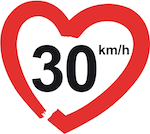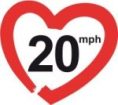Can children be adapted to road traffic?
What a child needs to be like, to be well adapted to road traffic…..
…. minimum 1,50 m in height,
….. having the body proportions of an adult: with a rather small head and the balancing point around the stomach/pelvis area. Adults don´t fall over as much as children do,
…. having a vision field of 180°
…. being able to do several things at the same time and understand complex situations,
….having walking and sprinting abilities of a trained athlete with lightning fast reactions but without need for moving, playing and tumbling around,
…. Being always fully attentive and good at following rules,
….. being without any curiosity whatsoever.
No child can be adapted like this; therefore, road traffic must adapt to children. Where kids are walking or cycling, 50 km/h (30 mph) are definitely too fast.
Why 20mph School Safety Zones can have only minimum impact on child road safety
Take the UK, for example: The mean radius of school safety zones is just 300m, yet the mean distance travelled to school is 1.8km. Hence the school safety zones apply to only 17% of the journey.[i] And at exit gateways to school safety zones drivers are reminded of the increase in the speed limit to 30mph. No wonder, only a small minority of child road casualties occur on the way to or from school (Just 20%).[ii]
But what of the child who walks or cycles all the way from their home to school. The school safety zone now only works for 17% of their journey. The 20mph school safety zones reinforce and legitimise the belief among drivers that once out of the immediate location, they can drive faster, hence increasing the risk to pedestrian and cycling children.
Instead of focussing on school safety zones, we should be ensuring that children are given better conditions for walking and cycling for the whole route from their home to school. It’s time to recognise that we need community-wide safety for children and not just in the last 100m of their school journey.
In Germany, the number of children dying in road accidents while they were walking on the streets increased by 22% in 2010 compared to 2009.[iii] We might always be having to read figures like these unless we introduce 30 km/h (20 mph) everywhere in areas where children live.
For more information see 20splentyforus.org.uk


